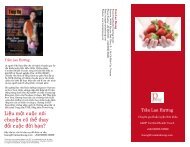NEWSLETTER MAY 2013.pdf - Integrative Nutrition Health Coach ...
NEWSLETTER MAY 2013.pdf - Integrative Nutrition Health Coach ...
NEWSLETTER MAY 2013.pdf - Integrative Nutrition Health Coach ...
Create successful ePaper yourself
Turn your PDF publications into a flip-book with our unique Google optimized e-Paper software.
oneself with people that have a positive influence on one’s life, etc. Eating consciously and making simple<br />
lifestyle changes (without all the suffering and craving that goes along with dieting) will create positive results<br />
and release you from the endless cycle of dieting.<br />
Given half a chance, your body will balance out by itself, but this is only possible by getting out of the diet<br />
mentality and listening to what you truly need. Imagine taking all of the outward energy you expend on diets,<br />
fads and gimmicks and turning it inward, so that you can listen to your heart and inner wisdom. There is no such<br />
thing as a quick fix; you already have everything you need within you. With careful thought and loving reflection,<br />
you can feed yourself in a nourishing way. Working with your body rather than against it will bring you increased<br />
energy, stabilized weight and sustainable health.<br />
Food Focus: Sprouts<br />
In the spring season, seeds flaunt their vitality and energy by sprouting. Sprouts of all varieties contain the<br />
building blocks of life in the form of vitamins, enzymes, amino acids and simple sugars. In their early growth<br />
state, sprouts are very easy to digest, allowing our bodies to access many wonderful nutrients. Recent research<br />
by the American Cancer Society has backed what holistic nutrition has known for years: that sprouts contain<br />
anti-cancer properties, high levels of active antioxidants, concentrated amounts of phytochemicals and<br />
significant amounts of vitamins A, C and D.<br />
In their raw form, sprouts have a cooling effect on the body, and therefore are best consumed in warm weather<br />
or by robust, warm body types. Those who tend to feel cool can try steaming spouts or adding them to warm<br />
dishes such as stir-fries and soups, to reduce the cooling effect. There is a wide<br />
variety of edible and delicious sprouts, each with a different texture and flavor:<br />
alfalfa, mung bean, lentil, radish, clover, sunflower, broccoli, garbanzo and adzuki.<br />
Here are some great ways to serve up sprouts:<br />
Add to salads.<br />
Combine with other vegetables in wraps, roll-ups or stir-fries.<br />
Use as garnish on top of soups, stews, omelets or scrambled eggs.<br />
Add to rice or whole-grain dishes.<br />
Use in sandwiches instead of lettuce.<br />
Spring has arrived! Eat sprouts and feel alive!<br />
The sun is out: Vitamin D and sunscreen<br />
With a scare created on skin cancer and the possible link with sunbathing without sunscreen, many people have<br />
been using sunscreen inappropriately, unknowingly creating a problem for themselves by not getting enough<br />
sun to make sufficient Vitamin D in the body. With far-reaching consequences!<br />
About 40 years ago is when our problem with regards to this subject started. At that point the cosmetics industry<br />
realized it could increase sales by going beyond beauty issues to target health concerns, put sunscreen into<br />
beauty products and then scared people into believing that any sunlight is dangerous.<br />
While it appears to be possible that too much sun may indeed cause cell carcinoma, there’s overwhelming<br />
evidence that the sun both causes common skin cancer and prevents internal cancers. While getting frequent<br />
sunburns, especially as a child, does increase the risk of malignant melanoma, few people know that frequent<br />
sun exposure, without burning, actually decreases melanoma risk. Nor do most people know that melanoma are<br />
most likely to occur on areas of the body not chronically exposed to sunlight, such as the back and upper legs.<br />
So, how much sun do we need to get sufficient Vitamin D?<br />
The wisest course is to get safe, reasonable, and regular full-body sun exposure during the warm months and<br />
either judiciously use sun tanning parlors or supplements in the winter, recognizing that scientists and doctors<br />
don’t know everything.<br />
One should be out in the sun, around noon is best, or at least at a time when your shadow is shorter than you<br />
are, without sunscreen for about 15-30 minutes with as much bare of your body as possible. The important thing<br />
© <strong>Integrative</strong> <strong>Nutrition</strong>
















